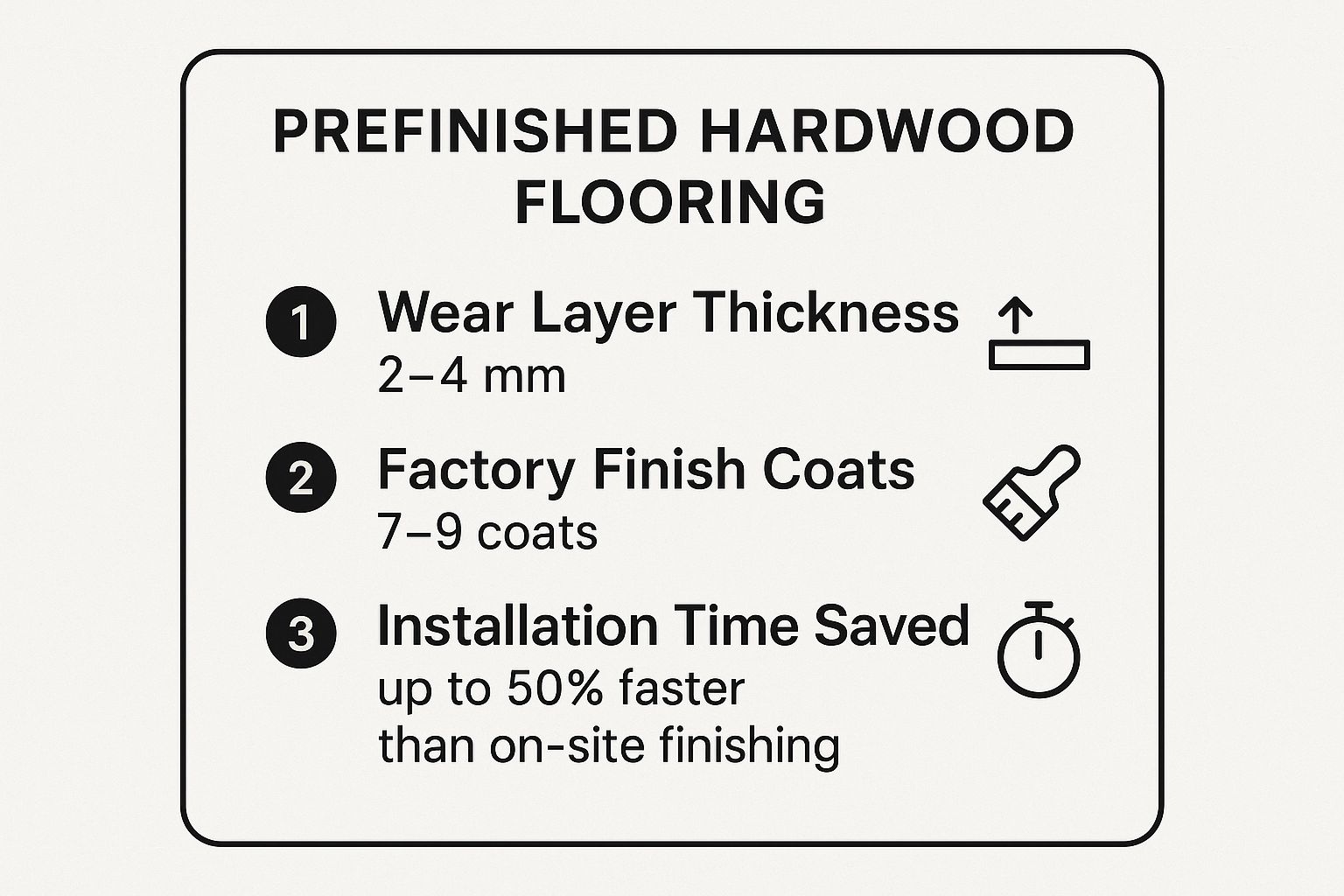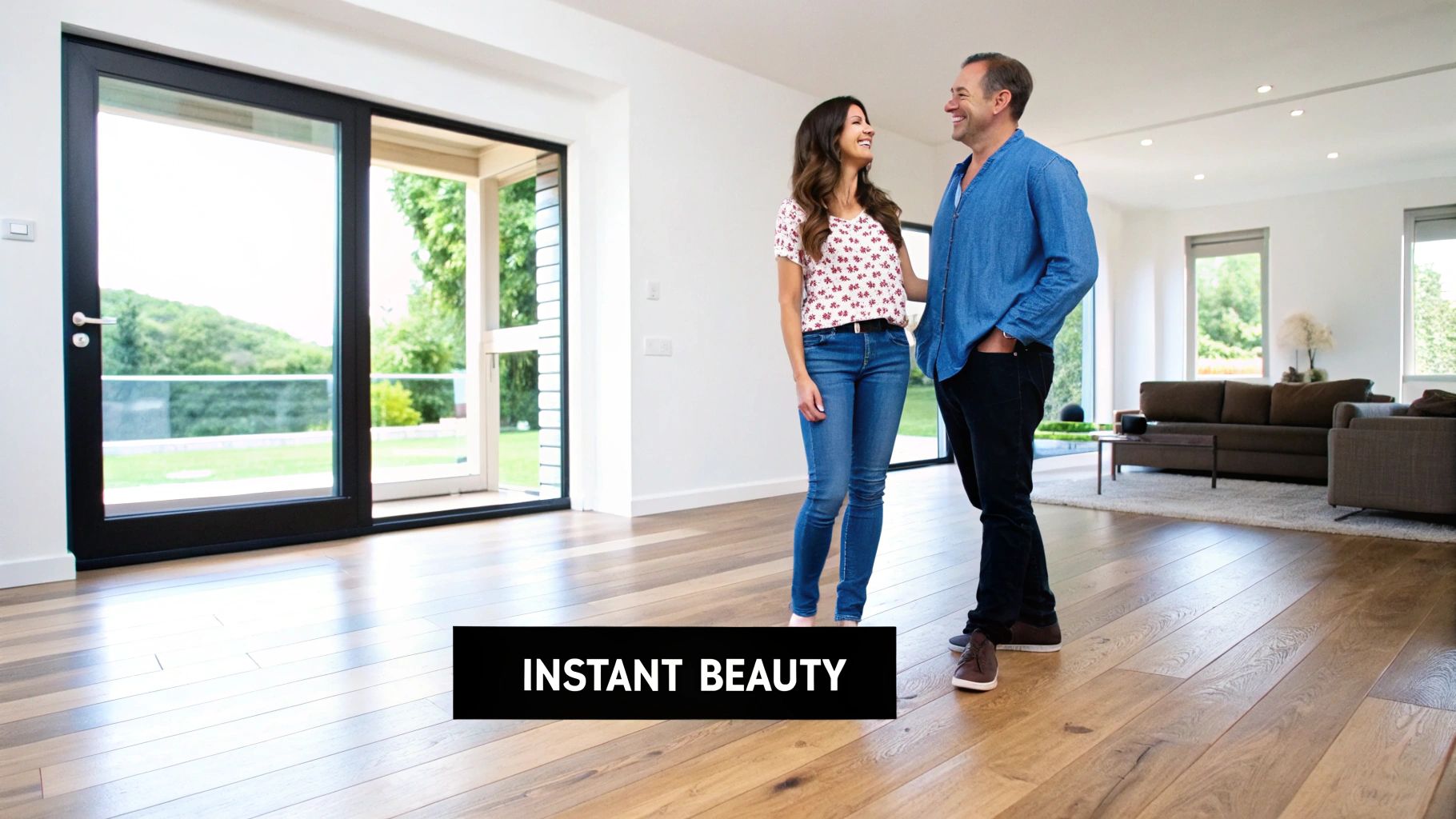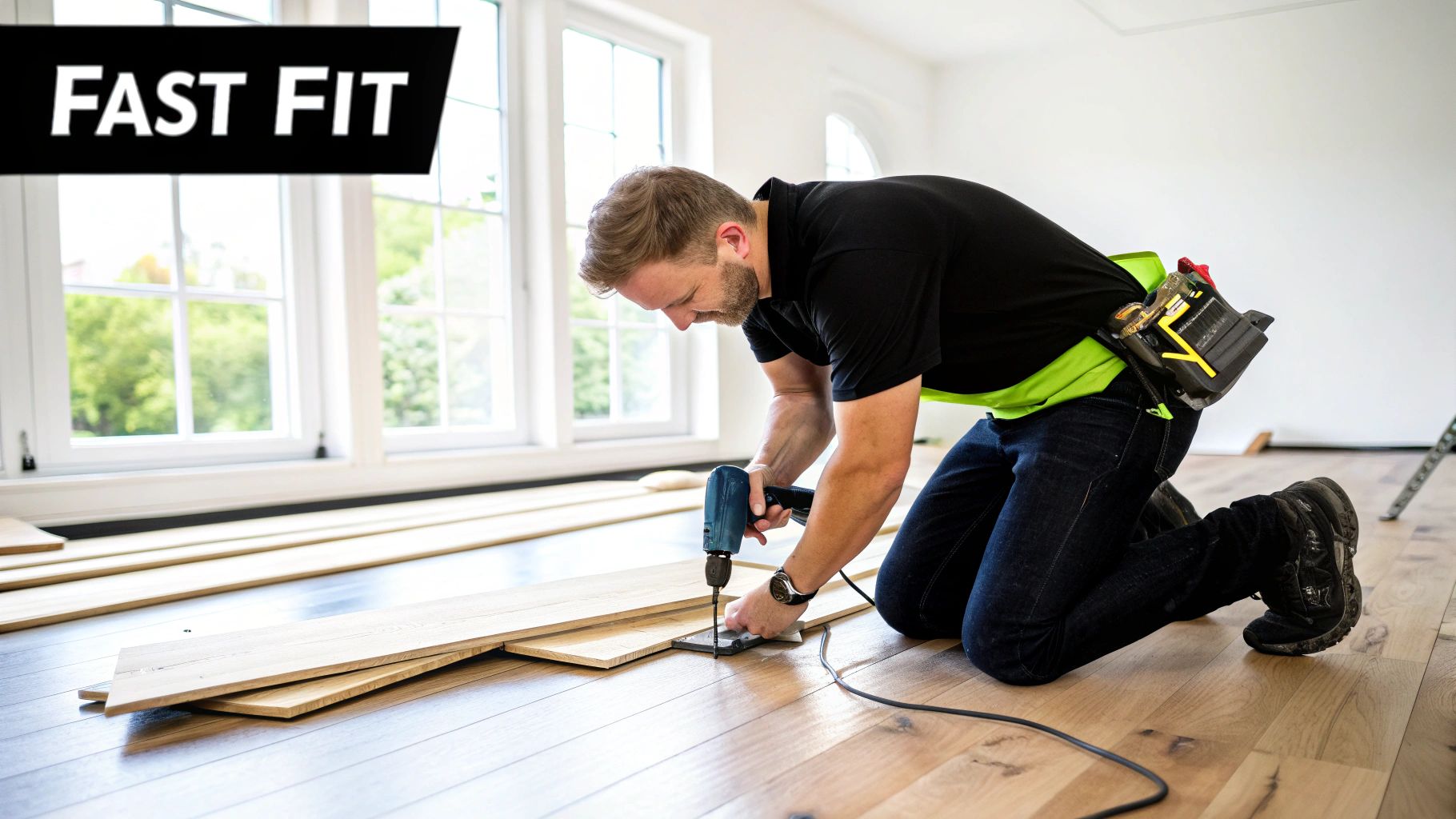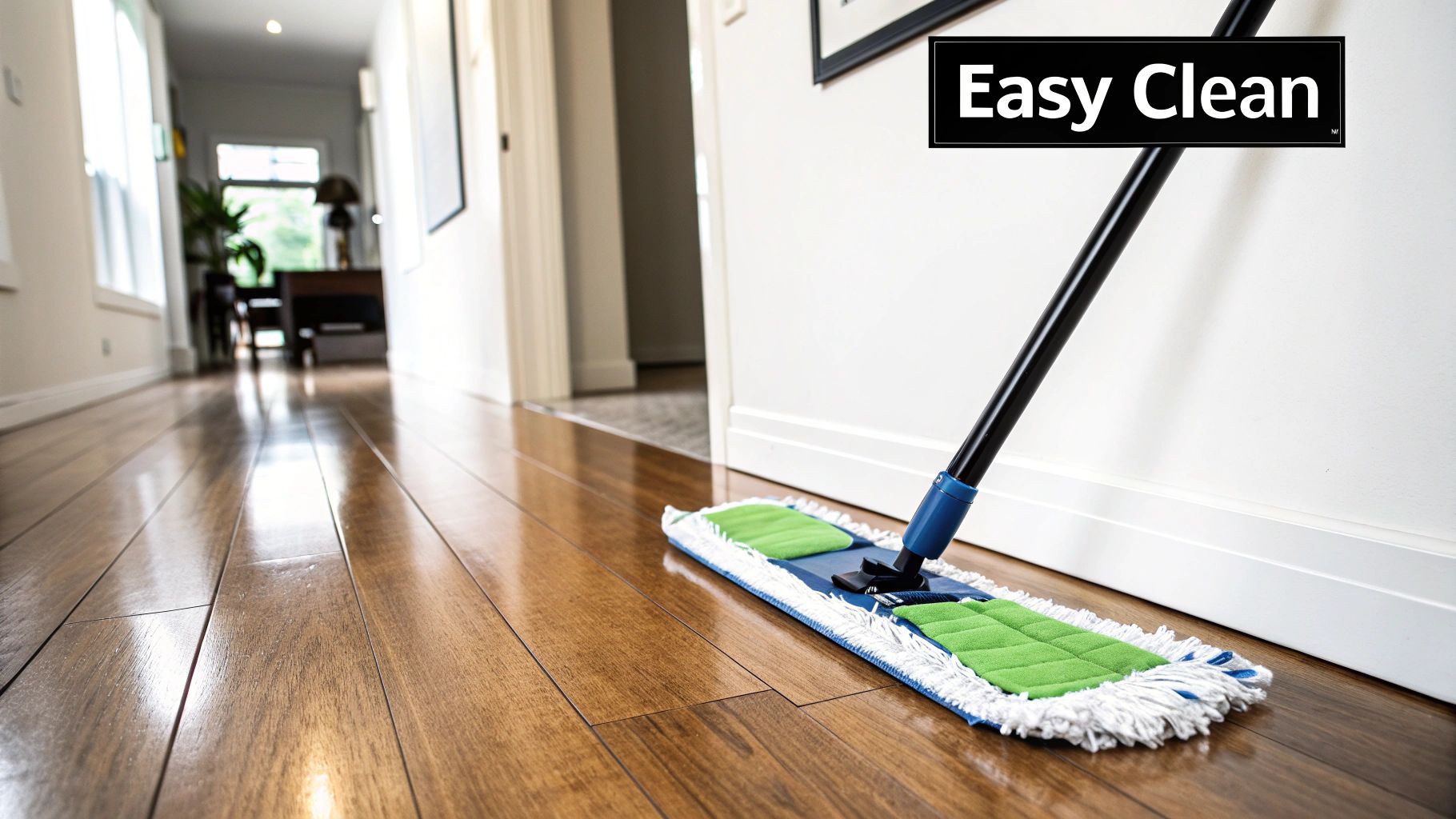So, you're exploring hardwood flooring options and keep hearing the term "prefinished." What exactly does that mean?
In the simplest terms, prefinished hardwood is flooring that arrives at your home completely finished. The sanding, staining, and sealing are all done in a controlled factory environment before the planks are even boxed up. This means it's a ready-to-install product right out of the gate, which is a huge shift from traditional flooring that requires all the messy finishing work to be done inside your house.
What Is Prefinished Hardwood Flooring?
Think of it like this: buying prefinished hardwood is like getting a brand-new car straight from the assembly line, with its flawless, factory-applied paint job. The alternative—site-finished flooring—is more like buying a primed car and having a local shop paint it in your garage. While a skilled pro can do a great job, the factory setting allows for a level of precision, consistency, and durability that’s nearly impossible to match on-site.
The big idea here is that all the labor-intensive, smelly, and dusty work is done before the flooring ever crosses your threshold. You get a perfect finish from day one and can walk on your new floors almost immediately after installation.
This factory-first approach is what makes prefinished flooring such a game-changer for homeowners.
As you can see, the factory process builds in layers of protection while drastically cutting down the time you have to wait to enjoy your beautiful new floors.
The Anatomy of a Prefinished Plank
When you pull a prefinished plank out of the box, you're holding a finished product. It's not just a raw piece of wood; it has gone through a meticulous, multi-step process to get it ready for your floor.
Here’s what happens at the factory:
- Precision Sanding: Each board is sanded to an incredibly smooth, uniform surface using industrial-grade machinery. This eliminates the minor imperfections and unevenness that can happen with portable sanders used in a home.
- Controlled Staining: The color is applied in a controlled environment, guaranteeing a consistent, rich tone from board to board and batch to batch. This avoids the blotchy spots or overlap marks that can sometimes plague site-finished jobs.
- Advanced Sealing: This is where prefinished really shines. Planks receive multiple coats—often 7 to 9 layers—of a powerful, commercial-grade finish that's far tougher than standard polyurethane.
Why the Factory Finish Matters
It’s not just about convenience; it’s about durability. That factory finish is typically an aluminum oxide-infused urethane, which is one of the hardest and most durable finishes available today.
These layers are cured instantly under powerful UV lights, creating a rock-hard shell that’s much more resistant to scratches, scuffs, and daily wear and tear. A finish applied on-site simply air dries, and it can't achieve that same level of hardness. This robust, factory-cured protection is precisely why so many homeowners now choose prefinished hardwood. You get stunning looks without sacrificing long-term durability.
To give you a clearer picture, let's break down the key differences between the two options side-by-side.
Prefinished vs. Site-Finished Hardwood At a Glance
| Feature | Prefinished Hardwood | Site-Finished Hardwood |
|---|---|---|
| Installation Time | Fast (1-2 days). Walk on it immediately. | Slow (3-7 days or more). Needs time to dry. |
| Mess & Fumes | Minimal dust. No chemical smells. | Very dusty from sanding. Strong fumes from stains & sealers. |
| Finish Durability | Extremely durable (factory-cured aluminum oxide). | Good durability, but less resistant than factory finishes. |
| Color/Sheen | What you see is what you get. Limited to factory options. | Fully customizable. Endless color and sheen combinations. |
| Board Edges | Typically has a microbevel between planks. | Perfectly flat, seamless surface once sanded. |
| Upfront Cost | Often higher material cost, but lower labor cost. | Lower material cost, but higher labor cost. |
| Repairs | Challenging. Requires replacing individual boards. | Easier to spot-repair and refinish the entire floor. |
This table shows the trade-offs. Prefinished offers incredible convenience and durability, while site-finished provides ultimate customization. Your choice really depends on what matters most for your project, timeline, and lifestyle.
The Power of a Factory-Applied Finish
So, what makes the “prefinished” part of this flooring so incredibly tough? It’s not just one magic ingredient. It's a combination of powerful materials and a meticulously controlled factory process.
Think of it like this: you can bake a delicious cake in your home oven, but a professional pastry chef using a commercial kitchen has total control over temperature, humidity, and timing. The result is consistently perfect every time. That’s the same advantage a factory has when finishing hardwood.
Each plank of wood travels down a finishing line in a dust-free, climate-controlled environment. Here, specialized machinery applies a finish that’s virtually impossible to duplicate in a residential setting.
This factory method didn't just appear out of nowhere. It was created as a direct solution to the mess, fumes, and long wait times of finishing floors on-site. Today, it’s a global standard, with many manufacturers using eco-friendly coatings that reduce harmful VOCs compared to traditional methods. You can learn more about the growth of sustainable hardwood flooring on imarcgroup.com.
The Science of Superior Durability
The real secret to its strength is in the coating itself. Manufacturers apply multiple layers—often seven to nine coats—of a seriously advanced urethane sealer. But this isn't the polyurethane you'd find at a hardware store; it’s supercharged with aluminum oxide.
Aluminum oxide is a naturally occurring mineral that’s one of the hardest substances on earth, right behind diamonds. When it's infused into the urethane finish, it creates a transparent shield that’s incredibly resistant to wear and tear.
Key Insight: Imagine the aluminum oxide particles as microscopic bodyguards for your floor. They're suspended in the finish, creating a tough, protective barrier that defends against scratches, scuffs, and the daily abuse of foot traffic.
This high-tech recipe is precisely why prefinished floors are famous for their longevity. The finish doesn’t just sit on the surface; it’s bonded deep into the wood to form a hardened, protective layer.
Curing for Maximum Hardness
Applying the coats is only half the job. The curing process is what truly locks in that legendary strength. Between each coat of finish, the planks are zapped with high-intensity Ultraviolet (UV) light. This industrial process cures the finish almost instantly, forging a powerful chemical bond between each layer and the wood itself.
This UV-curing technique offers huge advantages over letting a finish air-dry in your home:
- Maximum Hardness: The finish is as hard as it will ever be the moment it leaves the factory. Site-applied finishes can take weeks to fully cure and harden.
- Perfectly Smooth Surface: The factory environment is free of dust, pet hair, and other airborne specks that can ruin a finish, resulting in a flawless, glass-like surface.
- Exceptional Adhesion: UV light triggers a cross-linking reaction in the urethane, making it stick to the wood far better than any air-dried finish could.
This entire meticulous process is why prefinished hardwood often comes with incredible warranties, sometimes for 25 to 50 years. Manufacturers can stand behind their product with confidence because they've controlled every step, engineering a floor that’s built to last right out of the box.
Understanding Solid vs. Engineered Prefinished Hardwood
When you start shopping for prefinished hardwood, you'll quickly notice two main options: solid and engineered. They both show up at your door with that tough, factory-applied finish, but what’s going on inside each plank is totally different. Understanding that difference is crucial for picking the right floor for your home and lifestyle.
Think of it this way: solid hardwood is like a classic sculpture carved from a single block of wood, while engineered is like a modern composite sculpture, made of expertly bonded layers. Both are real wood and look incredible, but how they're built gives them very different strengths. This choice is a huge part of figuring out "what is prefinished hardwood flooring" for your specific project.
The Classic Choice: Solid Hardwood
Solid prefinished hardwood is as straightforward as it gets. Each plank is milled from a single, solid piece of timber. This is the way hardwood flooring has been made for generations, and it’s famous for its timeless character and incredible lifespan.
The biggest perk of solid hardwood is its sheer thickness. Because it’s one solid piece from top to bottom, it can be sanded and refinished many times over its life. And that life can easily stretch beyond 100 years! This means you can change the stain color or fix deep scratches decades from now, giving your floors a whole new look.
But solid wood does have an Achilles' heel: moisture. Wood naturally expands and contracts with shifts in humidity and temperature. Because of this, you absolutely cannot install it in damp areas like basements or directly onto a concrete slab.
The Modern Solution: Engineered Hardwood
Engineered prefinished hardwood is the clever, modern answer to wood's stability problem. Instead of one solid chunk, an engineered plank is built in layers, kind of like a high-tech piece of plywood. You get a top layer of beautiful, real hardwood—the part you see and feel—which is bonded to a core of several crisscrossing layers of wood or high-density fiberboard.
This layered construction is where the magic happens.
Key Advantage: By turning the grain direction with each new layer in the core, the plank fights its natural urge to warp, swell, or shrink. This gives it incredible structural integrity, making it far more stable in places with fluctuating humidity.
This stability is exactly why engineered hardwood is the hero for tricky installations:
- Basements: It can handle the below-grade moisture conditions that would destroy a solid wood floor.
- Condos: It’s the perfect solution for installing over the concrete subfloors found in most high-rise buildings.
- Radiant Heating: Many engineered wood floors are specifically designed to be installed over radiant heating systems.
Thanks to these benefits, the engineered wood market is booming. People love its versatility and reliability, which is why you see it everywhere now. You can dive deeper into the numbers on the global engineered wood market at Precedence Research.
What Are the Real Perks of Prefinished Floors?
So, beyond getting your floors installed quickly, what’s the real story with prefinished hardwood? It turns out the advantages are pretty compelling, making it a genuinely smart choice for the long haul. We're talking about benefits that touch on everything from durability and air quality to the final, beautiful look of your home.
The secret is in the factory-controlled process, which gives you a superior product right out of the box. Let's dig into the most significant benefits you'll get when you go with prefinished hardwood.
Built-in Strength and Durability
The biggest win here is, without a doubt, the finish. When floors are finished on-site, they might get two, maybe three, coats of polyurethane. Prefinished planks, on the other hand, come with seven to nine coats of a tough-as-nails, commercial-grade urethane sealer infused with aluminum oxide.
This industrial finish is baked on with powerful UV lights, creating an incredibly hard, protective layer. It's far more resistant to scratches, scuffs, and the general chaos of daily life than any finish that can be applied in your home. It’s ready for anything from day one.
A Healthier Home from the Start
Think about the traditional finishing process: all that sanding, staining, and sealing releases a ton of dust and Volatile Organic Compounds (VOCs) right into your living space. Those chemical smells can hang around for days, sometimes even weeks.
With prefinished hardwood, all that messy, fume-filled work is done in a specialized factory environment. That means no sanding dust and no toxic fumes in your home. You get a safer, healthier space for your family the moment the installation is complete.
No Waiting, Just Living
One of the most practical perks is how fast you can get back to normal. As soon as prefinished flooring is down, you’re done. You can move your furniture back in and start enjoying your beautiful new floors that very same day.
There's absolutely no waiting around for finishes to dry or cure. This completely cuts out days of disruption, letting you reclaim your home without delay.
Picture-Perfect Quality and Consistency
Because every single plank is stained and sealed by precision machinery in a factory, the final result is perfectly consistent. You get the same color and sheen from one board to the next, with no risk of human error like brush marks, drips, or patchy spots.
- Uniform Color: The stain is applied flawlessly for a consistent hue across your entire floor.
- Perfect Sheen: The factory finish is smooth and even, without any imperfections.
- Defined Look: The slight bevel on the edges of prefinished planks gives each board a distinct, clean look that adds character to the room.
These benefits add up to much more than just a pretty floor; they impact everything from long-term durability to the air you breathe. While prefinished is a fantastic option, it's also good to understand the general benefits of hardwood flooring to see how it all fits together in your home improvement journey.
Navigating Installation and Project Costs
When you start looking at the numbers for a new hardwood floor, it's easy to get a little sticker shock. You'll probably notice that prefinished hardwood planks often have a higher price per square foot than their unfinished cousins. But don't let that initial number fool you.
To get the real picture, you have to look at the total project cost. The magic of prefinished flooring is what you don't have to budget for. Since all the sanding, staining, and finishing happens in a factory, you get to skip the hefty labor bill that comes with doing all that work in your home. When you add it all up, prefinished hardwood often comes out as the more affordable, hassle-free option.
Choosing the Right Installation Method
Once you've picked your beautiful new floors, the next big question is how to get them in place. The best method really boils down to two things: what your subfloor is made of (the layer underneath the flooring) and whether you went with solid or engineered wood.
There are three main ways to tackle the installation:
- Nail-Down: This is the old-school, tried-and-true method. We nail the planks right into a wooden subfloor, creating an incredibly solid and durable floor. It's the standard for solid hardwood.
- Glue-Down: If you're working with a concrete subfloor, you can't exactly nail into it. Instead, we use a powerful adhesive to glue the planks directly to the concrete. This is a very common approach for engineered hardwood.
- Floating (Click-Lock): A lot of modern engineered flooring comes with a brilliant click-lock system. The planks just snap together, and the whole floor "floats" over a thin underlayment pad. No nails, no glue, just a fast and clean installation.
Getting this choice right is crucial for a long-lasting floor. If you want to dive deeper into the process, our guide on professional hardwood floor installation walks you through everything you need to know.
The Most Important Step: Acclimation
Before a single board gets laid, there is one step you absolutely cannot, under any circumstances, skip: acclimation. It sounds technical, but it’s simple. You just need to let the boxes of flooring sit in your home for a few days to get used to the unique temperature and humidity of the space.
Critical Tip: Skipping acclimation is the number one reason floors fail. Wood that hasn't adjusted will either shrink after installation, leaving you with ugly gaps, or expand and cause the boards to buckle and warp.
A little patience here goes a long way, ensuring your floor stays flat, tight, and beautiful for decades. This blend of quality and convenience is why the demand is soaring. The North American wood flooring market, where prefinished hardwood is a major player, was valued at around USD 7.66 billion and is expected to grow to USD 9.54 billion. It’s clear that homeowners are voting with their wallets for floors that deliver beauty without the headache. You can learn more about the North American wood flooring market on marketdataforecast.com.
Maintaining Your Prefinished Hardwood Floors
You’ve made a great choice with prefinished hardwood. That tough, factory-applied finish is built to last, but keeping it looking brand new for years to come really comes down to a simple, consistent care routine. The whole point is to protect that beautiful, durable surface so it looks incredible for decades.
First, let's talk about what not to do. It’s a huge misconception that you can just grab any old household cleaner. Things like vinegar and water are actually a terrible idea—the acid will slowly eat away at the finish, leaving it dull and vulnerable. Steam mops are another big no-no. That combination of intense heat and moisture is a recipe for disaster, capable of damaging both the finish and the wood itself.
Your Simple Maintenance Routine
The good news? You don’t need to spend hours scrubbing. Keeping your floors pristine is all about having the right approach, not working harder. A simple routine is your best weapon against everyday wear.
Make it a habit to sweep or vacuum at least once a week. Use a soft brush attachment to pick up all that fine grit and dust that can act like sandpaper under your feet. And when spills happen—and they will—wipe them up right away with a soft, dry cloth. You want to stop moisture from having any chance to seep between the planks.
For a deeper clean, it is absolutely crucial to use a pH-neutral cleaner that is specifically made for prefinished floors. Using the wrong stuff won't just look bad; it can actually void your warranty and strip away the protective layer.
Long-Term Prevention Strategies
Beyond just cleaning, a few smart habits will go a long way in protecting your investment. Think of these as your floor’s long-term defense plan against scratches and damage.
- Use Furniture Pads: Stick felt pads on the bottom of every single piece of furniture. This is non-negotiable for preventing scratches when a chair gets pushed back or a table gets bumped.
- Place Mats at Entryways: A good doormat at every exterior door is your first line of defense. It will trap the dirt, tiny rocks, and moisture that would otherwise get tracked all over your beautiful floors.
- Maintain Indoor Humidity: Wood breathes, and it reacts to the environment around it. Try to keep your home’s humidity between 35% and 55% all year. This simple step helps prevent the planks from gapping in the winter or buckling in the summer.
Following these tips will make protecting your floors feel effortless. For a more in-depth look, be sure to check out our complete guide on how to maintain hardwood floors.
Got Questions About Prefinished Hardwood? We've Got Answers.
Even after laying out all the benefits, we know that choosing the right flooring for your home is a big decision. It’s a real investment, and it’s only natural to have a few questions swirling around. When you're trying to wrap your head around "what is prefinished hardwood flooring," you really want to know how it's going to hold up for years to come.
So, let's get straight to it. Here are the honest answers to the most common questions we get from homeowners just like you.
Can You Refinish Prefinished Hardwood Flooring?
Yes, you absolutely can—but how you can refinish it boils down to the type of plank you choose. This is a huge point of confusion for many people, so let’s make it simple.
Solid prefinished hardwood can be sanded and refinished multiple times over its life, just like the old-school hardwood floors you’re familiar with. Because each plank is one solid piece of wood, there's plenty of material to work with as the decades go by.
Engineered prefinished hardwood is a different story. Whether it can be refinished depends entirely on the thickness of its top layer—that beautiful, real-wood veneer. Most engineered floors can be carefully sanded and refinished once or twice. This is a delicate job, though. That factory finish is incredibly tough, so we always recommend hiring a pro to avoid accidentally sanding right through the veneer.
Is Prefinished Flooring Really More Expensive Than Unfinished?
If you're just looking at the price tag on a box of planks, prefinished hardwood often looks a bit pricier per square foot. But that’s only looking at half the picture.
The real secret is to look at the total installed cost. With prefinished flooring, you dodge a huge chunk of labor costs. You’re completely cutting out the expensive, messy, and time-consuming process of sanding, staining, and sealing the floor inside your home.
When you add it all up, the final project cost for a prefinished floor is usually very similar to, or sometimes even less than, a site-finished one.
How Do You Fix a Scratch on a Prefinished Floor?
Dealing with damage is actually one of the quiet perks of prefinished floors. You don't have to tear up your life and refinish an entire room just to fix one ugly scratch.
-
For light, surface-level scuffs, a manufacturer-provided touch-up kit is your best friend. These kits come with markers or fillers that are a perfect match for your floor’s specific color and sheen, making those minor blemishes practically vanish.
-
For deeper gouges or more serious damage, the solution is surprisingly simple: just replace the one bad plank. A skilled flooring installer can pop out the damaged board and slot a new one in its place. It’s a targeted fix that’s worlds away from the disruption of sanding down an entire room.
Ready to see if prefinished hardwood is the perfect fit for your home? The experts at Ramos Wood Floor LLC are here to walk you through the options and help you find a beautiful, durable floor that matches your style and your budget. Contact us today for a free consultation!





